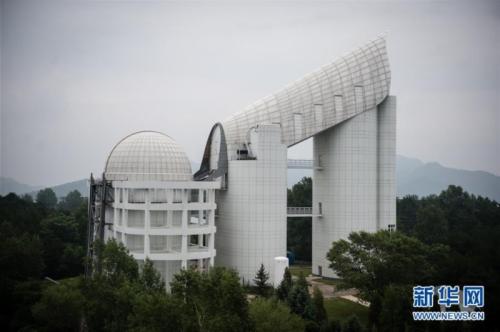


China’s Large Sky Area Multi-Object Fiber Spectroscopy Telescope (LAMOST) (Photo/Xinhua)
China’s Large Sky Area Multi-Object Fiber Spectroscopy Telescope (LAMOST) has helped the country make a series of breakthroughs in astronomical studies in recent years. It has not only recalculated the size of the Milky Way, but also found a fixed star with the highest abundance of lithium discovered so far.
“It was unimaginable in the past,” said Zhao Yongheng, a researcher with the National Astronomical Observatories, Chinese Academy of Sciences, explaining that the researches performed before were always limited by observation equipment.
Zhao pointed out that with the advanced and sensitive large telescope, they could see farther and clearer and thus renew their knowledge about the universe.
Nowadays, large and powerful apparatuses are indispensable for scientific discoveries and technological innovation, from observing the cosmic galaxies billions of light-years away to the basic particles that make up the world.
Since the 1980s, China has begun to invest in the construction of large scientific facilities. According to incomplete statistics, over 30 such facilities have been built and put into operation.
Building large scientific equipment has greatly boosted the development of China’s basic research and advanced technologies, bringing the country’s science and technologies to a higher level.
In 1988, China successfully built its first physics collider, the Beijing Electron-Positron Collider (BEPC). As another major breakthrough in China’s high-tech industry after the country achieved success in developing its first atomic and hydrogen bombs and the first man-made satellite, it has officially introduced China’s research in high-energy physics to the world.
Since the reform and opening-up, China has built many large-scale scientific facilities, such as LAMOST, Shanghai Synchrotron Radiation Facility (SSRF), the Five-hundred-meter Aperture Spherical Radio Telescope (FAST), China Spallation Neutron Source (CSNS), and the experimental advanced superconducting tokamak (EAST), with many representing the most advanced level in the world.
In the future, more major scientific facilities will be built and put into operation in China, and they will play more important roles in areas such as attraction of talents, making of technological breakthroughs, and promotion of innovation.
 Fire brigade in Shanghai holds group wedding
Fire brigade in Shanghai holds group wedding Tourists enjoy ice sculptures in Datan Town, north China
Tourists enjoy ice sculptures in Datan Town, north China Sunset scenery of Dayan Pagoda in Xi'an
Sunset scenery of Dayan Pagoda in Xi'an Tourists have fun at scenic spot in Nanlong Town, NW China
Tourists have fun at scenic spot in Nanlong Town, NW China Harbin attracts tourists by making best use of ice in winter
Harbin attracts tourists by making best use of ice in winter In pics: FIS Alpine Ski Women's World Cup Slalom
In pics: FIS Alpine Ski Women's World Cup Slalom Black-necked cranes rest at reservoir in Lhunzhub County, Lhasa
Black-necked cranes rest at reservoir in Lhunzhub County, Lhasa China's FAST telescope will be available to foreign scientists in April
China's FAST telescope will be available to foreign scientists in April "She power" plays indispensable role in poverty alleviation
"She power" plays indispensable role in poverty alleviation Top 10 world news events of People's Daily in 2020
Top 10 world news events of People's Daily in 2020 Top 10 China news events of People's Daily in 2020
Top 10 China news events of People's Daily in 2020 Top 10 media buzzwords of 2020
Top 10 media buzzwords of 2020 Year-ender:10 major tourism stories of 2020
Year-ender:10 major tourism stories of 2020 No interference in Venezuelan issues
No interference in Venezuelan issues
 Biz prepares for trade spat
Biz prepares for trade spat
 Broadcasting Continent
Broadcasting Continent Australia wins Chinese CEOs as US loses
Australia wins Chinese CEOs as US loses